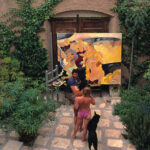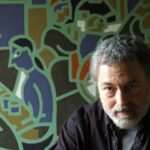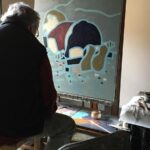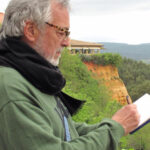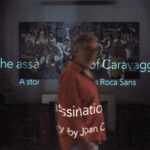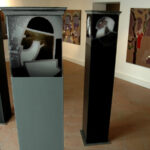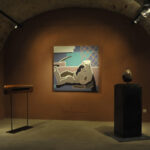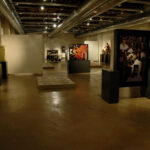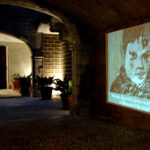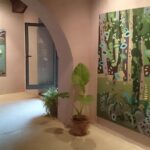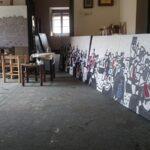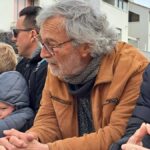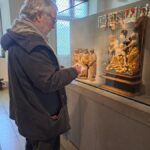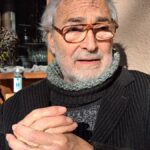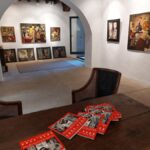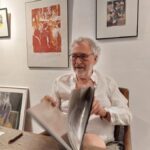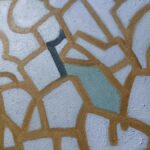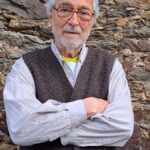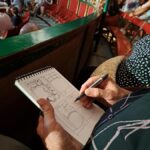BIOGRAPHY
Born in Barcelona in 1946, Joan-Carles Roca Sans began painting in the late 1970s, when the avant-garde still dominated the art scene, and decided to swim against the tide. He learn the basics of the trade at the Faculty of Fine Arts and look towards classical Greece and the Renaissance, developing his own style with a postmodern will, giving yourself over to the revision of certain aspects of the art of the past with content inspired by his own experiences. In the mid-1980s, his proposals are in line with others that appeared in Italy and Germany, where he spent long periods (Stuttgart, Dusseldorf and Munich) from where he absorbed the strength of the Central European tradition, synthesizing expressionism.
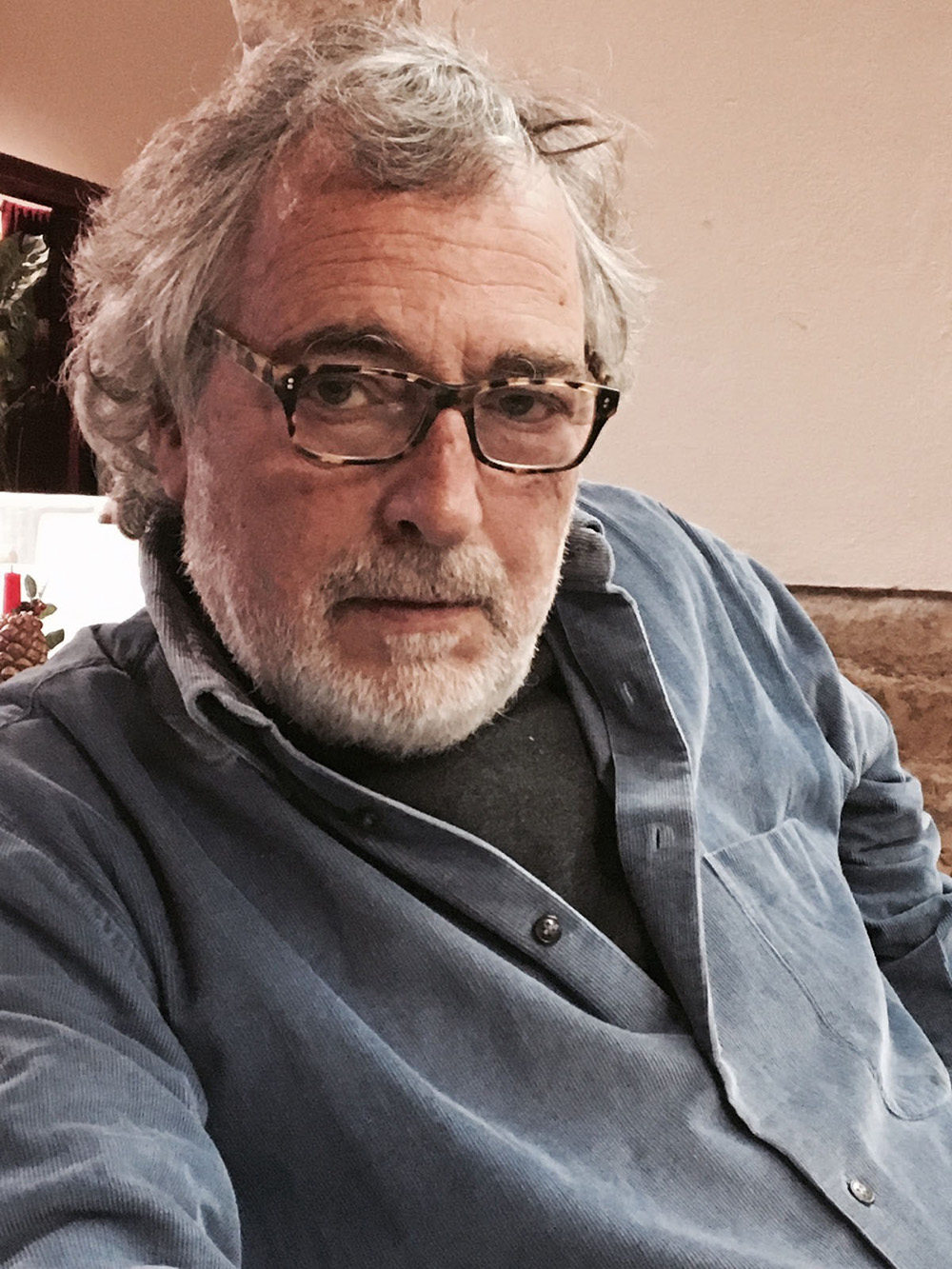
As of 2000, he incorporates different temporalities and reinvents the synthetic expressionism that he had already created fifteen years before, using the line of the drawing as a key element for the distribution of colors. He maintains and perfects his commitment to capture life, draw it and paint it to be part of it. Although with pop and urban roots, his work is characterized by an internal coherence and an overflowing personal iconography. In this painter it is impossible to separate life and work, that is why each painting is like a page of his biography. He has created more than one hundred individual exhibitions and his works have entered numerous public and private collections.
Over the last ten years, Roca Sans has traveled the Mediterranean and explained the experience of each trip, publishing fourteen episodes with a wide thematic repertoire through fictional stories and visual arts that incorporate painting, sculpture and graphic novels with the application of new technologies, highlighting the fixation of light on supports such as marble and methacrylate as well as graphic novels in video format. This is the Ermoupoli project, which the artist canceled in 2017 to continue exploring through strict painting the polysemic availability of the image and to seek a narrative where each viewer can build their own story.
Pre 2000
Roca Sans continues to develop a personal style that emerges in Munich in 1985 and which can be defined as synthetic-expressionist. Since then and for fifteen years, the castle at Palau-Sator is where he develops his artistic and existential world.
THE LOST PARADISE 1974-1984
1974/79 – Roca Sans was inspired by the writings of Giulio Carlo Argan about revival and defined himself as post-avantgardist before words as post modern or transvanguardism were invented. For the painter, what is not tradition is copy, and also has the obsession to explain the world and life. He does not understand Art but as a chance to give a personal view of the human condition and therefore he must be narrative. The Book The Experience of the Empordà involves finding a lost Arcadia in a disappearing rural world, with a mark up symbolic language.
1980 – His series Pastorals Empordaneses give an overview of Mediterranean life from a nostalgic urban perspective. It is an exercise of symbolic construction, which delimit landscape to convert it in territory, as it would be, a territory “lived and updated more than represented” in a Bergsonian conception of the term.
1981/82 – In his book L’Empordà, pictorial poetry, is summarized in twenty-six pictures of large format an interpretation of this cultural landscape. Language is here synthetic and Mediterranean.
1983 – The collection A Mediterranean proposal provides the result of journeys that the painter do to the Balearics and the Greek islands of the Aegean, which leave him a lasting impression and where he promises to return in the future.
1984 – The artist performs actions in architectural and natural spaces in Spain and Germany. Disappointed by the trivialization and degradation of the territory, the Fragmentation Cycles marks a full stop within the artistic dialogue with Nature.
NIGHT LIGHTS 1985-1999
1985/86 – Like many artists of his generation Joan Carles Roca Sans spends time abroad, mainly in Germany and ended settling in Munich, articulating a language that more or less coincides with others proposals appeared in New York, Berlin or Roma. It is the series Tanzende. Years lived in the Bavarian capital marked a turning point and manhood becomes the permanent centre of the discourse.
1987/91 – Buys the castle of Palau-sator. Years later, the Fundació Catalunya Nostra grants the award Castells Culturals for this restoration. Since then “The Palau Tower” becomes a pioneer place where cultural activities take place. These years he arrives to a personal fusion of classicism and expressiveness that Jaume Fàbrega christens as “synthetic-expressionism”.
1992/93 – Roca Sans explore the half of Europe (Berlin, Munich, Zurich, Dusseldorf, Amsterdam, Prague, etc…) to observe life, to catch her and thus become part of it. José Luis Jiménez-Frontin in The looking and gesture portrays his characters as executioners of primitive sacrifices, and calls them as a successful fauna of victims and butchers.
1994 – His book The night drawn, collecting drawings made in 92, is a bittersweet and nostalgic look at the night in a city that will nevermore be the same.
The Ruiners and The Night Watch folders of silkscreen are also edited.
1997 – The catalogue The Night of the Hunter by Josep Mª Cadena shows us with a language vital and narrative a summary of experiences ranging from 92 to 96, making a plastic parable of postmodern society from a playful segment of it.
2000 – Publication of the book Obra 1974-1999, where the artist himself explains his motives and intentions over these years and we see that in fact, every painting is a page of his biography. The order is chronological and gives rise to the following sections: Paradise Lost, A Mediterranean proposal, Cycles of fragmentation, The Years of Munich, Time looking at time, Night Lights, Barcelona: the neighbourhood drawn, Two by two, Water Mirrors, Rembrandt: the light, Of a time superhuman, Jade Palaces and Travel blogs.
Post 2000
Established in Torroella de Montgrí, the artist reinvents his style with the incorporation of the new temporalities. The Ermoupoli Project starts with the increase in migratory flows and ends when the rise in populist parties endangers the cohesion of the European Union.
THE CONQUEST OF LIGHT 2002-2006
2002/2006 – A fourteen century manor house in the centre of Torroella de Montgrí, renovated and expanded in seventeen century, offers to the painter the exhibition spaces which present the most daring proposals, combining contemporary work with painting and sculpture of the past. Atrium Torroella, which is story and journey at the same time, commits for quality and originality. Is not a museum, but a concept open to changes and experiences where aesthetics are at the service of ideas.
2002 – A Halloween night in the disco Paradiso merges with a world of angels and demons to give born the book Knowledge is a sin? Is death?, a tribute to the poet John Milton.
2007 – Brau Edicions publishes he book The Light and the Cannon. After going through dramatic experiences, pursuit of light knows a renewed drive and becomes obsession. Retrieving many previous aspects of their language, Roca Sans comes to another, gradually more abstract and essential. Building on the experiences of the 80s, when he synthesized expressionism, he checks Baroque representative patterns and combining the filtered with the projected light, he reaches a way of representing space by balancing temperatures. With something as simple as realizing that the line of drawing makes the difference between the figure and the background, without requiring a change of colour, he gives a new reading to the figurative art. This book is a catalogue reasoned from articles and lectures of the artist on aesthetics. The cataloguing is thematic and the repertoire shows are catered The colors of Arcadia, Eva mestiza, The tamer of utopias, The look of complicity, If all is light … Virtual Stars, After the steps of Mitra.
THE ERMOUPOLI PROJECT 2007-2016
A beach of colored marbles, the desire to recover the youth, the transformative power of travel, a story where what matters is the journey and not the arrival, giving rise to Ermoupoli book. It is the starting point for the project of the same name that continues a literary tradition that emerged in the Renaissance: a collection of stories set at different locations in the Mediterranean, where several characters have experiences that transform their lives.
The Ermoupoli Project is characterized by love for the experiment, the understanding of the artistic experience as a fragment and as a fusion of different anthropological levels: emotion and concept, play and seriousness, reason and feeling, order and chaos. This is his spirit. It shows the obsessive presence of the trinomic sex, life and dead, that articulate the trajectory of the artist.
FULL LINE 2017…
Having completed the Project in 2016, Roca Sans decides to trace the most hidden secrets of his own pictorial phenomenon, where the narrative allows the spectator to build his own story.






